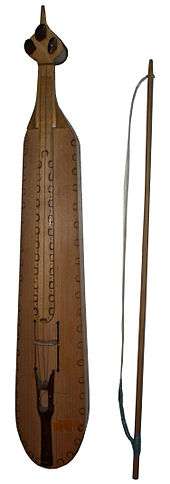Turkish tambur
The tanbur (spelled in keeping with TDK conventions) is a fretted string instrument of Turkey and the former lands of the Ottoman Empire.[1] Like the ney, the armudi (lit. pear-shaped) kemençe and the kudüm, it constitutes one of the four instruments of the basic quartet of Turkish classical music a.k.a. Türk Sanat Müziği (lit. Turkish Artistic Music). Of the two variants, one is played with a plectrum (mızraplı tambur) and the other with a bow (yaylı tanbur). The player is called a tanburî.[2]
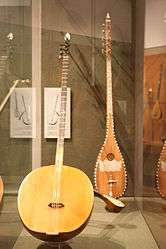 Turkish tanbur on the left | |
| Other names | Turkish tanbur, Ottoman tanbur |
|---|---|
| Classification | String instrument |
| Playing range | |
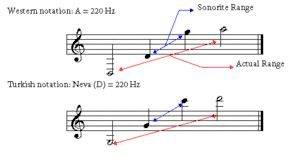 | |
| Related instruments | |
| Musicians | |
| |
| Builders | |
| |
History and development
There are several hypotheses as to the origin of the instrument. One suggests that it descended from the kopuz, a string instrument still in use among the Turkic peoples of Central Asia and the Caspian region.[3] The name itself derives from the tanbur (tunbur). Tanbur in turn might have descended from the Sumerian pantur.[2] The name (and its variants such as tamboura, dombura) also denotes a wide spectrum of pear-shaped string instruments in Persia and Central Asia yet these share only their names with the Ottoman court instrument and in fact are more akin to bağlamas or sazes. As of the 17th century, the tanbur had already taken its present form and structure and assumed the preponderant role it still holds in Classical Turkish Music performance.[2]
Description of the instrument
Tanburs are made almost entirely of wood. The shell (Tekne) is assembled from strips of hardwood called ribs joined edge to edge to form a semi-spherical body for the instrument. The number of ribs traditionally amounts to 17, 21 or 23, yet examples with slightly wider and consequently fewer ribs (7, 9 or 11) can also be found among older specimens. Traditionally, thinner strips called fileto are inserted between the ribs for ornamental purposes, but are not obligatory.[2] The most common tonewood veneers used for rib-making are mahogany, flame maple, Persian walnut, Mecca balsam wood (Commiphora gileadensis), Spanish chestnut, Greek juniper, mulberry, Oriental plane, Indian rosewood and apricot. Ribs are assembled on the bottom wedge (tail) and the heel on which the fingerboard is mounted.
The soundboard (Göğüs) is a rotund thin (2.5–3 mm) flat three-, two- or single-piece plate of resonant wood (usually Nordmann, silver or Greek fir). This circular plate measuring about 30 to 35 cm in diameter is mounted on the bottom wedge and the heel with simmering glue and encircled with a wooden ring. A soundhole is either wanting or consists of a very small unornamented opening (mostly in historical specimens), giving the instrument its peculiar sonority.
The neck (Sap) is a mince (only 4-4.5 cm in diameter) 100–110 cm long D-section fingerboard made of light wood and carries catgut frets adjusted to give 36 intervals in an octave. Catgut frets are fixed on the neck by means of minute nails. The main bridge is trapezoidal and mobile, and since the shell lacks braces to support the soundboard, the latter slightly yields in under the bridge. The smaller upper bridge between the pegbox and the neck is traditionally made of bone.[2]
The plectrum is made of tortoiseshell and is called "bağa" (meaning turtle). Cut in an asymmetrical V-form and polished at 45° on the tip, it measures 2-2.5 mm × 5–6 mm × 10–15 cm.
Nowadays the tanbur has seven strings. In the past tanburs with eight strings were not uncommon.
A Variant: The Yaylı Tanbur
The yaylı tanbur has a similar physical appearance, although the shell -a nearly perfect semi-sphere- might be made of metal. It is played with a bow instead of a plectrum. The technique was introduced by Tanburi Cemil Bey in the end of the 19th century. Ercüment Batanay was, after Tanburi Cemil Bey, the most outstanding virtuoso of this instrument, until his death. The yaylı tanbur is held vertically on the knees, as opposed to the regular one where the neck is maintained horizontal to the ground at all times.
Performers and techniques
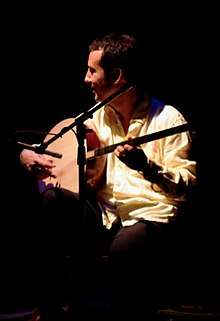
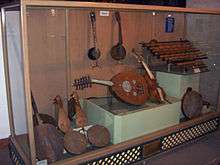
Owing to its long past, the tanbur has let flourish several schools of interpretation. The oldest description of tanburîs is reported by the French traveller Charles Fonton who describes the use of catgut frets.[4] A Turkish musical theory written in the beginning of the 18th century by the famous Kantemir Pasha -first an Ottoman citizen of Polish-Moldovian origin, then voivode of Moldovia- elucidates for the first time the proper intervals to use.[5]
Yet there is little mention of playing styles and the first tanbur master recorded by chronicles and of whom we have solid information is Tanburi İzak Effendi,[6] who is said to have brought the playing technique to maturity. Today, he is considered as the reference of the "old style" in tanbur playing, partially recovered in the 20th century by Mesut Cemil.[7] Sheikh of the Rifai Tekkesi in Kozyatağı (Istanbul) Abdülhalim Efendi was his pupil and carried on the same tradition.
Among notable 18th-century players were Numan Agha, Zeki Mehmed Agha, Tanburî Küçük Osman Bey, all of whom remained representatives of this allegedly old style. The first virtuoso to claim renovation was Tanburi Büyük Osman Bey who broke with his father Zeki Mehmed Agha's technique to present his own. Later on, this later style became so prevalent that the older technique came to suffer oblivion. The musical heritage transmitted to Suphi Ezgi by Abdülhalim Efendi, and from the former to Mesut Cemil, an eminent figure in 19th Turkish Classical Music, has helped retrieve the essentials of this old technique. One last important tanburi successfully performing according to principles of the old school was Cemil Özbal (1908–1980)[8] from Gaziantep.
Yet the most renowned and probably the most prolific of tanburis is Tanburi Cemil Bey, who not only excelled in virtuosity but bequeathed a heritage that later prominent figures of Turkish Classical Music such as Neyzen Niyazi Sayın and Tanburi Necdet Yaşar claimed.
See also
- Category:Tanbur players
References
- Scheherezade Qassim Hassan; Morris, R. Conway; Baily, John; During, Jean (2001). "Tanbūr". In Sadie, Stanley; Tyrrell, John (eds.). The New Grove Dictionary of Music and Musicians. xxv (2nd ed.). London: Macmillan. pp. 61–62.
- Tanbur Republic of Turkey - Ministry of Culture and Tourism
- ÖZKAN, İsmail Hakkı, Türk Mûsıkîsi Nazariyatı ve Usûlleri, Ötüken Neşriyat : Istanbul (Turkey), 2000 (6th Edition).
- FONTON, Charles, Essai sur la musique orientale comparée à la musique européenne : où l'on tâche de donner une idée générale de la musique des peuples de l'orient, 17th century in NEUBAUER, Eckhard, Der Essai sur la musique orientale von Charles Fonton mit Zeichnungen von Adanson, Frankfurt am Main : Institute for the history of Arabic Islamic science, 1999.
- Dimitrie Cantemir: A Global Man of Music TR Kültür Sanat Edebiyat
- Pamela Dorn Sezgin, “Fresco Romano, Isaac (Tanburi Izak)”, in: Encyclopedia of Jews in the Islamic World, Executive Editor Norman A. Stillman
- Mesut Cemil Biography
- Listen to composition by Cemil Ozbal
